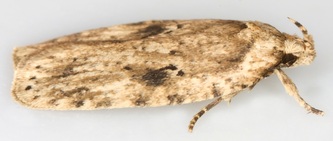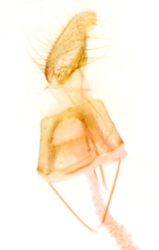32.017 Agonopterix arenella (Brindled Buff)
ws: 16-22mm; Sep-May; thistles (Carduus and Cirsium spp), knapweeds (Centaurea spp), burdocks (Arctium spp), saw-wort (Serratula tinctoria); common throughout GB.
ID: from key in MBGBI4.1: Forewing not dark purplish or crimson-brown, without white dot in disc; foreleg with tibia and tarsus buff brown (not uniformly dark fuscous or black on upper aspect); S3 of labial palps with dark markings, including black or fuscous tip; apical half of fw terminal cilia not contrastingly pink to purplish-brown; fw with black or cloudy fuscous blotch in disc at 1/2, (not at 3/5 and not extending towards tornus); fw underside with fuscous discal area contrasting strongly with buff border; fw with fuscous line near base from dorsum to ~half way across wing > A.arenella/propinquella.
These two are distinguished in the key by: fw buff, irregularly suffused brown, with a short fuscous streak near termen along V6 = A.arenella vs fw evenly suffused brown, without streak along V6 = A.propinquella
Specimen §1 seems typical but ID not confirmed by genital examination. Specimen §2 ditto but taken in July at least 5 weeks earlier than quoted emergence dates. Specimen §3 was also taken in July and ID was confirmed by genital examination. I have also taken an extremely worn specimen of this species, confirmed by genital dissection (not illustrated here) on Mull on 02/07/11 - so it seems this species may be obtained all year in GB. Specimens §4&5 were taken in early August and ID confirmed by genital examination in §5; §5 shows a less distinct basal fuscous line. The fuscous streak along V6 does not seem to be a very distinct marking but is discernable in all specimens examined so far.
These two are distinguished in the key by: fw buff, irregularly suffused brown, with a short fuscous streak near termen along V6 = A.arenella vs fw evenly suffused brown, without streak along V6 = A.propinquella
Specimen §1 seems typical but ID not confirmed by genital examination. Specimen §2 ditto but taken in July at least 5 weeks earlier than quoted emergence dates. Specimen §3 was also taken in July and ID was confirmed by genital examination. I have also taken an extremely worn specimen of this species, confirmed by genital dissection (not illustrated here) on Mull on 02/07/11 - so it seems this species may be obtained all year in GB. Specimens §4&5 were taken in early August and ID confirmed by genital examination in §5; §5 shows a less distinct basal fuscous line. The fuscous streak along V6 does not seem to be a very distinct marking but is discernable in all specimens examined so far.
|
§1 Foulness, Essex; 07/09/2008; fw 9.5mm
§2 Foulness, Essex; 26/07/2009; fw 9.0mm §3 Foulness, Essex; 26/07/2009; male; fw 9.4mm §4 Foulness, Essex; 09/08/2009; male; fw 9.3mm §5 Foulness, Essex; 09/08/2009; female; fw 9.4mm §6 Foulness, Essex; 25/04/2010; fw 9.9mm §7 Foulness, Essex; 10/10/2010; male; fw 9.8mm §8 Foulness, Essex; 08/09/2011; female; fw 8.8mm §9 Strumpshaw Fen, Norfolk; 25/05/2012; male All images © Chris Lewis |
§10 Foulness, Essex; 09/09/2012; female
§11 Bampton Grange, Cumbria; 15/09/2016; male; fw 10.0mm §12 Pound Wood, Essex; 17/08/2019; female; fw 9.3mm §13 Callestick, Cornwall; ??/04/2023; male |
Page published 02/01/2012 | §9 added 24/06/2012 | §10 added 13/09/2012 | §11 added 04/06/2017 | §12 added 17/12/2019 |
§13 added 23/05/2023
§13 added 23/05/2023
































